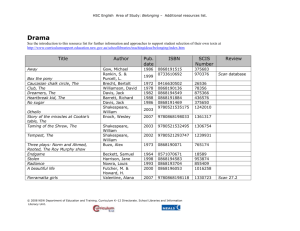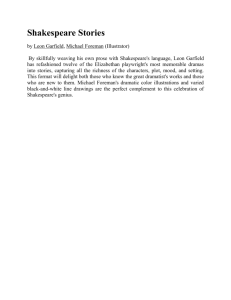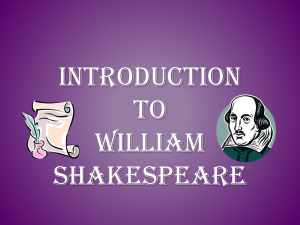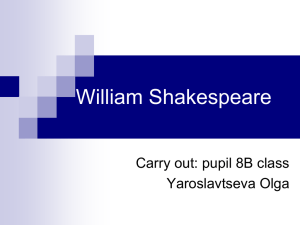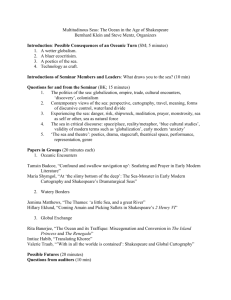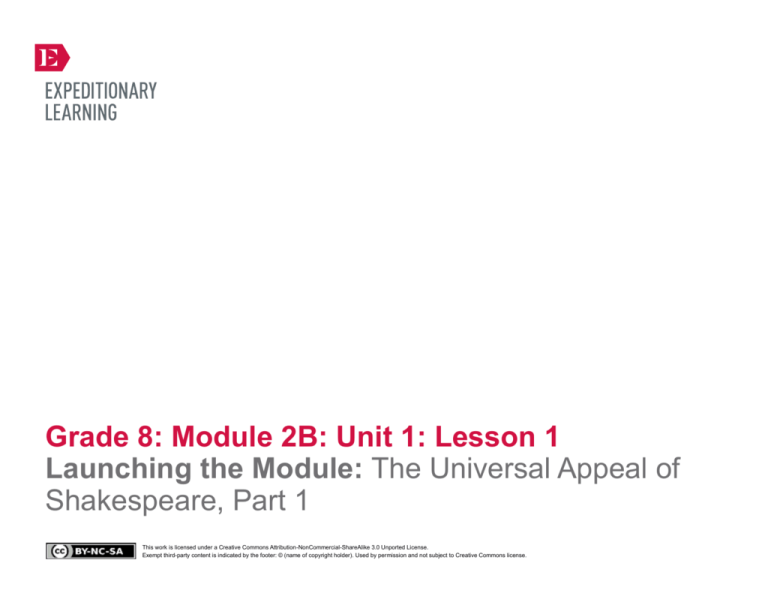
Grade 8: Module 2B: Unit 1: Lesson 1
Launching the Module: The Universal Appeal of
Shakespeare, Part 1
This work is licensed under a Creative Commons Attribution-NonCommercial-ShareAlike 3.0 Unported License.
Exempt third-party content is indicated by the footer: © (name of copyright holder). Used by permission and not subject to Creative Commons license.
GRADE 8: MODULE 2B: UNIT 1: LESSON 1
Launching the Module:
The Universal Appeal of Shakespeare, Part 1
Long-Term Targets Addressed (Based on NYSP12 ELA CCLS)
I can evaluate the advantages and disadvantages of using different media to present an idea. (RI.8.7)
Supporting Learning Targets
Ongoing Assessment
• I can describe information from images about the universal appeal of Shakespeare.
• Notice/Wonder note-catcher
• I can explain the advantages and disadvantages of gathering information from images.
Created by Expeditionary Learning, on behalf of Public Consulting Group, Inc.
© Public Consulting Group, Inc., with a perpetual license granted to Expeditionary Learning
Outward Bound, Inc.
NYS Common Core ELA Curriculum • G8:M2B:U1:L1 • June 2014 •
1
GRADE 8: MODULE 2B: UNIT 1: LESSON 1
Launching the Module:
The Universal Appeal of Shakespeare, Part 1
Agenda
Teaching Notes
1. Opening
• This lesson launches Module 2B and begins to build students’ background knowledge about the
universal appeal of William Shakespeare’s works. As students engage in a Gallery Walk, they use images
to help build this background knowledge.
A. Engaging the Reader: Gallery Walk (15 minutes)
B. Reviewing Learning Targets (5 minutes)
2. Work Time
A. “The Lure of Shakespeare”: Read-aloud (20 minutes)
3. Closing and Assessment
A. Debriefing Learning Targets (5 minutes)
4. Homework
A. Complete the Advantages/Disadvantages T-chart.
• Students also read along as the teacher reads aloud a text that further develops their background
knowledge about Shakespeare. This read-aloud gives students a chance to hear a fluent reader model
difficult text. This is a “pure” read-aloud, with no interruptions. Read to model fluency and help build
understanding.
• Students then consider the advantages and disadvantages of learning about Shakespeare from images
and text.
• This is a two-part lesson. Students will return to the topic of the universal appeal of Shakespeare in
Lesson 7. Hold on to the Gallery Walk images to use again in that lesson.
• In advance: Review the Gallery Walk protocol (see Appendix); prepare and post the photographs for the
Gallery Walk (see links in the supporting materials).
• Post: Learning targets.
Lesson Vocabulary
Materials
inferences, universal appeal, images,
advantages, disadvantages, lure
• Gallery Walk image sources (for teacher reference; see Teaching Note)
• Notice/Wonder note-catcher (one per student and one to display)
• Document camera
• Timer
• “The Lure of Shakespeare” (one per student and one for read-aloud)
• Advantages/Disadvantages T-chart (one per student)
Created by Expeditionary Learning, on behalf of Public Consulting Group, Inc.
© Public Consulting Group, Inc., with a perpetual license granted to Expeditionary Learning
Outward Bound, Inc.
NYS Common Core ELA Curriculum • G8:M2B:U1:L1 • June 2014 •
2
GRADE 8: MODULE 2B: UNIT 1: LESSON 1
Launching the Module:
The Universal Appeal of Shakespeare, Part 1
Opening
Meeting Students’ Needs
A. Engaging the Reader: Gallery Walk (15 minutes)
• In advance, be sure to have posted the images from the Gallery Walk image sources throughout the room (or along the
hallway outside the classroom).
• Students engaged in a similar
Gallery Walk in Module 1, Unit 1,
Lesson 1. They may benefit from
engaging in the Gallery Walk with
assigned partners to control the
sharing and processing they are
doing during this time.
• Distribute the Notice/Wonder note-catcher and display a copy on a document camera.
• Explain the Gallery Walk protocol. Tell students that in a moment, they will examine several images that are posted. At each
image, they should pause and capture specific details they notice (e.g., “Actors on stage,” “Children performing a play”) and
the things they wonder about (“I wonder what play they are performing?” or “In what country is this play being
performed?”)
• Tell students that they will have just a minute at each image and that they might not get to all of the images.
• You might need to coach your students about your expectations for safe movement and for quiet voices during this work
period:
* “As you move from image to image, there is no need to engage in side conversations. I expect ‘zero’ voice levels during this
time. Also, please move carefully, taking care not to bump into one another.”)
• Consider partnering ELLs who
speak the same home language
when discussion of complex content
is required. This can allow students
to have more meaningful
discussions and clarify points in
their native language.
• Invite students to begin. Use a timer set to 7 minutes to keep students focused on the gallery. As the class completes this
activity, circulate to observe and support as needed.
• After about 7 minutes, ask students to return to their seats.
• Cold call several students to share what they noticed and wondered.
• Review for students that when they use their background knowledge to add meaning to an image or text, they are making
inferences.
• Ask:
* “What do all of these images have in common?”
• Invite students to turn and talk to a partner about this question. While pairs discuss, circulate and probe to encourage them
to move beyond the literal of what they see in the images to what they infer about the images.
• Cold call pairs to share their thinking.
Created by Expeditionary Learning, on behalf of Public Consulting Group, Inc.
© Public Consulting Group, Inc., with a perpetual license granted to Expeditionary Learning
Outward Bound, Inc.
NYS Common Core ELA Curriculum • G8:M2B:U1:L1 • June 2014 •
3
GRADE 8: MODULE 2B: UNIT 1: LESSON 1
Launching the Module:
The Universal Appeal of Shakespeare, Part 1
Meeting Students’ Needs
Opening (continued)
• Share with students that all of these images have to do with William Shakespeare. Point out that there are some images of
children, prisoners, and the elderly performing Shakespeare. There are images of a play by William Shakespeare, A
Midsummer Night’s Dream, being performed in Africa and Korea. There are also images of playbills or advertisements of
different productions of A Midsummer Night’s Dream, and there is a traditional image of William Shakespeare.
• Invite students to turn and talk:
* “Based on all of these images (people of different walks of life, ages, nationalities, etc.), what are some conclusions or
inferences you can make about Shakespeare’s works?”
• Cold call several pairs. Ideally, students will recognize that Shakespeare’s works are appealing to people across time and
cultures. (You will revisit this concept in Lesson 7; do not worry if students’ ideas are somewhat ill-formed or superficial at
this point.)
B. Reviewing Learning Targets (5 minutes)
• Invite a student to read aloud the first learning target:
* “I can describe the information from images about the universal appeal of Shakespeare.”
• Tell students that they are used to reading words to gather information about something, and today they “read” a different
type of text. They looked at images such as paintings, photographs, lists, etc., to gather information.
• Share that in Module 1, students studied the universal refugee experience, and in today’s Gallery Walk, they looked at images
that show the universal appeal of Shakespeare. Invite students to turn and talk:
* “What might the term universal mean?”
• Cold call pairs to share their thinking. Be sure they understand that the phrase universal appeal refers to the interest and
impact of Shakespeare’s works across time, cultures, ages, and walks of life.
• Read aloud the second learning target:
* “I can explain the advantages and disadvantages of gathering information from images.”
• Share with students that the experience of looking at images is different from reading about the same topic. Ask:
• “What do the words advantages and disadvantages mean?”
Created by Expeditionary Learning, on behalf of Public Consulting Group, Inc.
© Public Consulting Group, Inc., with a perpetual license granted to Expeditionary Learning
Outward Bound, Inc.
NYS Common Core ELA Curriculum • G8:M2B:U1:L1 • June 2014 •
4
GRADE 8: MODULE 2B: UNIT 1: LESSON 1
Launching the Module:
The Universal Appeal of Shakespeare, Part 1
Meeting Students’ Needs
Opening (continued)
• Invite students to turn and talk, then call on volunteers to answer. Draw students’ attention to the prefix dis- in the word
disadvantage. Remind them that dis- means “not” or “the opposite of something.” An advantage is a positive aspect of
something, and a disadvantage is a negative aspect of something. Share with students that they will have time to think about
the advantages and disadvantages of looking just at images to understand something.
Work Time
Meeting Students’ Needs
A. “The Lure of Shakespeare”: Read-aloud (20 minutes)
• Explain to students that now that they have built some background knowledge about the universal appeal of Shakespeare by
looking at images, they will learn a bit more by reading a text.
• This read-aloud supports all
learners in building basic
background knowledge.
• Distribute “The Lure of Shakespeare” to students. Explain that the word lure means “attraction” or “appeal.” Cold call a
student to predict what this article will be about based on this helpful definition. Ideally, students will understand that this
article will be about why people have found Shakespeare’s works to be appealing or interesting.
• Invite students to use their copy of the article to read along as you read it aloud.
• After reading, have students turn and talk to a partner:
* “What else did you learn about the universal appeal of Shakespeare from this article?”
• Cold call pairs to share what they learned.
• Ask:
* “What was different about learning from the article versus the images?”
• Invite students to turn and talk and cold call pairs to share their thinking.
Created by Expeditionary Learning, on behalf of Public Consulting Group, Inc.
© Public Consulting Group, Inc., with a perpetual license granted to Expeditionary Learning
Outward Bound, Inc.
NYS Common Core ELA Curriculum • G8:M2B:U1:L1 • June 2014 •
5
GRADE 8: MODULE 2B: UNIT 1: LESSON 1
Launching the Module:
The Universal Appeal of Shakespeare, Part 1
Meeting Students’ Needs
Closing and Assessment
A. Debriefing Learning Targets (5 minutes)
• Ask students to turn and talk after reading aloud each learning target:
* “I can describe the information from images about the universal appeal of Shakespeare.”
* “I can explain the advantages and disadvantages of gathering information from images.”
• Distribute the Advantages/Disadvantages T-chart and explain that students will have an opportunity to think about
and write about their learning from images and text for homework. Orient them to the handout and clarify as needed.
Homework
Meeting Students’ Needs
• Complete the Advantages/Disadvantages T-chart.
Created by Expeditionary Learning, on behalf of Public Consulting Group, Inc.
© Public Consulting Group, Inc., with a perpetual license granted to Expeditionary Learning
Outward Bound, Inc.
NYS Common Core ELA Curriculum • G8:M2B:U1:L1 • June 2014 •
6
Grade 8: Module 2B: Unit 1: Lesson 1
Supporting Materials
This work is licensed under a Creative Commons Attribution-NonCommercial-ShareAlike 3.0 Unported License.
Exempt third-party content is indicated by the footer: © (name of copyright holder). Used by permission and not subject to Creative Commons license.
GRADE 8: MODULE 2B: UNIT 1: LESSON 1
Gallery Walk Image Sources
(For Teacher Reference)
Title to display
under image
Image source
Children performing
AMND
http://www.shakespeareinamericanlife.org/images/midsummer_l.jpg
Shakespeare for the
elderly
http://assets.nydailynews.com/polopoly_fs/1.160862!/img/httpImage/im
age.jpg_gen/derivatives/landscape_635/alg-peoples-theater-jpg.jpg
Photo by Lloyd Wolf. Used with permission.
Enid Alvarez/News Used with permission
William Shakespeare
http://i.telegraph.co.uk/multimedia/archive/02488/shakespeare_punjab
_2488351b.jpg
Public domain.
World Shakespeare
Festival in Pictures
http://www.nosweatshakespeare.com/shakespeare-festival-in-pictures
Pacific Northwest
Ballet
http://www.flickr.com/photos/pacificnorthwestballet/8611337488/
Archangel
http://www.flickr.com/photos/iagoarchangel/3872234340/
Photo by Pacific Northwest Ballet
http://creativecommons.org/licenses/by-nd/2.0/
Photo by Jimmy Thomas http://creativecommons.org/licenses/by-sa/2.0/
Shakespeare Carolina
http://www.flickr.com/photos/rtencati/7770076416/
photo by Ron Tencati
http://creativecommons.org/licenses/by-nd/2.0/
Midsummer Puck
Flying
http://en.wikipedia.org/wiki/File:MidsummerPuckFlying.jpg
Shakespeare Behind
Bars
http://mediad.publicbroadcasting.net/p/wfpl/files/201305/shakespeareb
ehindbars.jpg
Pacific Repertory Theatre
http://creativecommons.org/licenses/by-sa/3.0/deed.en
photo by Holly Stone
2009 Shakespeare Behind Bars production of 'Macbeth' directed by Matt Wallace
Luther Luckett Correctional Complex, LaGrange, KY
Created by Expeditionary Learning, on behalf of Public Consulting Group, Inc.
© Public Consulting Group, Inc., with a perpetual license granted to Expeditionary
Learning Outward Bound, Inc.
NYS Common Core ELA Curriculum • G8:M2B:U1:L1 • June 2014 •
8
GRADE 8: MODULE 2B: UNIT 1: LESSON 1
Notice/Wonder Note-catcher
Name:
Date:
Notice
Created by Expeditionary Learning, on behalf of Public Consulting Group, Inc.
© Public Consulting Group, Inc., with a perpetual license granted to Expeditionary
Learning Outward Bound, Inc.
Wonder
NYS Common Core ELA Curriculum • G8:M2B:U1:L1 • June 2014 •
9
GRADE 8: MODULE 2B: UNIT 1: LESSON 1
The Lure of Shakespeare
by Robert Butler
From Past to Present
Many people consider Shakespeare the greatest writer in the English language. His legions of
admirers point with awe to the rhythm of his words and the wide range of human emotions he
portrays and evokes. But has Shakespeare always been so popular? And how did an Elizabethan actorturned-playwright become a world-famous figure?
From the start, Shakespeare was popular among the English. Shortly after his death, his plays were
published in a collection known as the First Folio (1623), with a poem by Ben Jonson included that
featured the lines, "He was not of an age, but for all time!" The memory of Shakespeare remained
strong among audiences as well, since his plays were produced regularly by many companies.
But in 1642. during the English Civil War, the theaters of London were closed by order of the
Government and remained so for 18 years. By the time they reopened in 1660, styles had changed.
The court of the new king wanted a more elegant, refined, classical world, and Shakespeare struck
them as coarse in his language and careless in his plots. His comedies, in particular, fell out of favor as
the years passed.
By the 1700s, however, a turnaround had begun. The first new edition of his plays in nearly a century,
along with the first biography ever written, appeared in 1709 and immediately sparked a Shakespeare
revival. Despite continuing questions about his style, which led many producers to cut or alter his
plays (sometimes even writing new endings for them), audiences were enthusiastic. Great
performances also helped. David Garrick, the greatest actor of the century, and Sarah Siddons, the
greatest actress, were both enthusiastic
Shakespeare supporters and starred in many of his plays at the Drury Lane Theatre.
In the 1800s, Shakespeare's popularity soared. Multivolume editions of his plays were published,
exuberant productions and extravagant sets supported stars such as Fanny Kemble and Edmund
Kean, and touring companies brought small-scale versions of Shakespeare to towns and villages
everywhere.
In the 20th century, Shakespeare remained as popular as ever, with actors such as Sir Laurence
Olivier, Sir John Gielgud, and Kenneth Branagh bringing his characters to life. Students around the
world now read Shakespeare in literature classes, and his plays are sometimes staged in modern-day
costume to emphasize his significance to today's world.
Created by Expeditionary Learning, on behalf of Public Consulting Group, Inc.
© Public Consulting Group, Inc., with a perpetual license granted to Expeditionary
Learning Outward Bound, Inc.
NYS Common Core ELA Curriculum • G8:M2B:U1:L1 • June 2014 •
10
GRADE 8: MODULE 2B: UNIT 1: LESSON 1
The Lure of Shakespeare
by Robert Butler
More remarkable is the story of Shakespeare's popularity in other lands.
News of Shakespeare's talent spread even during his lifetime. Occasionally, a foreign merchant or
diplomat saw a Shakespearean production. In 1601, the Russian ambassador was present when
Twelfth Night was first performed. Traveling companies of English actors staged some of
Shakespeare's plays in Germany and Poland while the playwright was still alive. But it was the great
French author Voltaire who truly popularized Shakespeare beyond English shores in the 1730s. From
that time onward, Shakespeare's works have been extensively studied and performed around the
world.
In America, copies of the plays are believed to have circulated in the late 1600s, and the first
performance was Romeo and Juliet in the early 1700s. A century later, Americans practically
worshiped Shakespeare. Philosopher and poet Ralph Waldo Emerson called him "the first poet of the
world." In the 1900s, Shakespeare's works were being translated and printed in India, Africa, China,
and Japan.
In the 20th century, a new medium inspired countless variations on the Shakespeare canon: the
movies. Some have been filmed as recreated plays, such us Romeo and Juliet (1968) or Henry V
(1989). Others were adapted stories in modern settings such as West Side Story (1961) or Richard III
(1995). Still others were transposed into stories in a completely different land and culture such as Ran
(1985), a Japanese tale of samurai based mostly on King Lear.
Whether recorded or live, the performance of a major Shakespeare role is traditionally seen as the
ultimate test of an actor's ability. From Richard Burbage in the 1500s to Ian McKellen and Judi Dench
today, the greatest actors are those who are able to master Shakespeare. By itself, this is the most
enduring tribute to the theatrical talent of William Shakespeare, the Bard of Avon.
From Calliope issue: William Shakespeare, Master Playwright, © 2005 Carus Publishing Company, published by Cobblestone Publishing, 30 Grove Street, Suite C,
Peterborough, NH 03458. All Rights Reserved. Used by permission of the publisher. www.cobblestonepub.com
Created by Expeditionary Learning, on behalf of Public Consulting Group, Inc.
© Public Consulting Group, Inc., with a perpetual license granted to Expeditionary
Learning Outward Bound, Inc.
NYS Common Core ELA Curriculum • G8:M2B:U1:L1 • June 2014 •
11
GRADE 8: MODULE 2B: UNIT 1: LESSON 1
Advantages/Disadvantages T-Chart
Name:
Date:
Shakespeare Images
What did you learn about the universal appeal of Shakespeare from looking at the images?
What are the advantages of using images in
learning about this topic? How is it positive or
helpful?
Created by Expeditionary Learning, on behalf of Public Consulting Group, Inc.
© Public Consulting Group, Inc., with a perpetual license granted to Expeditionary
Learning Outward Bound, Inc.
What are the disadvantages of using images in
learning about this topic? How is it negative or
unhelpful?
NYS Common Core ELA Curriculum • G8:M2B:U1:L1 • June 2014 •
12
GRADE 8: MODULE 2B: UNIT 1: LESSON 1
Advantages/Disadvantages T-Chart
“The Lure of Shakespeare”
What did you learn about the universal appeal of Shakespeare from reading the text?
What are the advantages of reading text to learn
about this topic? How is it positive or helpful?
Created by Expeditionary Learning, on behalf of Public Consulting Group, Inc.
© Public Consulting Group, Inc., with a perpetual license granted to Expeditionary
Learning Outward Bound, Inc.
What are the disadvantages of reading text to
learn about this topic? How is it negative or
unhelpful?
NYS Common Core ELA Curriculum • G8:M2B:U1:L1 • June 2014 •
13

